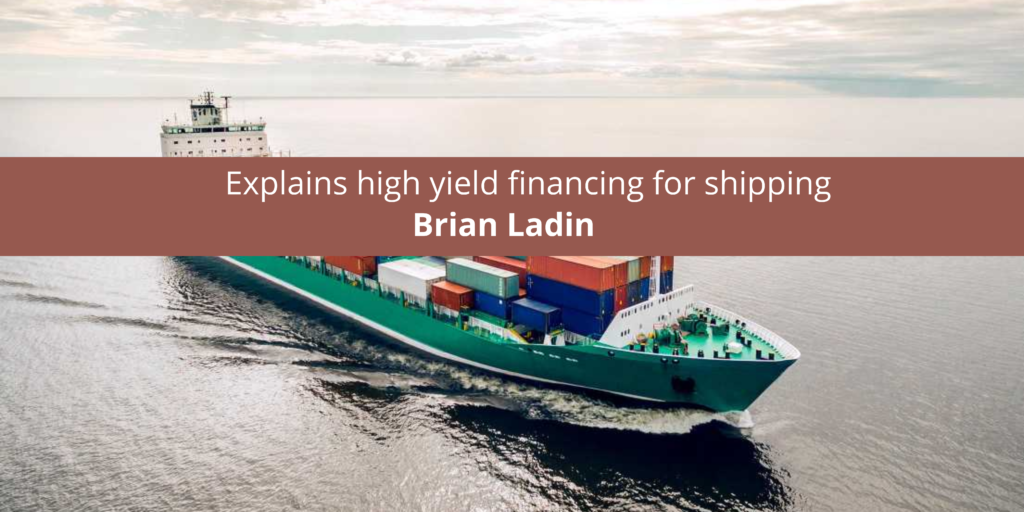Brian Ladin explains high yield financing for shipping


As one of the fastest-growing markets, shipping has slowly climbed to the top of the world’s for-profit industries. According to recent findings, it is estimated that the global value of it will reach $1.3 trillion in the next four years. Such expansion and size will be practically unprecedented given the relatively short amount of time that it needed to develop.
Surprisingly, however, not everything within this sector has been operating at a surplus. Even with the tremendous growth and many forward-thinking developments, the shipping market has gone through quite a few challenges over the past year or two. For example, it had to deal with a lot of new regulations that put a major strain on long-term prosperity. More importantly, however, it had to overcome a lot of issues that came from the fact that some of the primary financial providers for the shipping sectors decided to take a step back and leave the market. Fortunately, this has slowly but surely gotten replaced by something known as “high-yield financing.”
How the Industry Used to Operate
Over the past few decades, the vast majority of the growth within the shipping sector was directly related to the seemingly endless access to capital. The banks that provided such effortless financing were mostly based in Europe, and companies had the option to get enormous amounts of cash for incredibly low margins and little in the way of guarantees. After a while, having realized that such an uncertain business model is more of a liability than an asset, many of these banks started scaling back on their investments.
According to Hellenic Shipping News, bank-based lending has now fallen to a little over $300 billion, which is the lowest amount since 2008. Given that 2008 was a time of a major economic downturn, it is certainly alarming to see the financing fall by almost the same margin when the overall market is trending upwards.
As per Brian Ladin, however, it is important to note that there are a lot of new providers who managed to enter the sector just in time to offset some of the major losses. According to his analyses, the new players are mostly commercial banks focused in Asia, which is where many shipping companies have recently started relocating to. If it was not for these providers, the sheer number of banks that exited the shipping sector would have constituted unimaginable losses.
Smaller Investments
One trend that almost guaranteed the survival of the rapidly growing shipping sector is high-yield financing through smaller outlets. More precisely, if it was not for the bonds that have come to the market in the past 10 years, it would be impossible for the boom to continue. So, what exactly are these low-scale investments and how have companies been able to incentivize investors to join a sphere that is getting abandoned by nearly all of Europe’s large banks?
Amid the vacuum that was created by the sudden exit of many European banks, shipping operations, especially the smaller ones, turned to a new solution. Instead of putting their hopes and trust into single institutions that can hold a large chunk of their lending portfolio, they decided to turn to the capital debt market. This means that they figured out a way to tap into the enormous potential of mass-lending through the use of bonds. Doing so helped them improve the financing portion of their cash flow as many investors started buying the relatively low-interest bonds without worrying about the unsecured nature of this debt.
Hypothetically, if the industry suddenly declines or fails, there is a good chance that those who bought bonds will never see their investment again. In reality, however, the likelihood of something like this happening is slim to none given the need for worldwide shipping. This type of security is what led to a quick rise in lending as most folks who purchase bonds are not concerned about losing in the long run.
Where Bonds Beat Old-Fashioned Financing
As mentioned, bonds are extremely important when it comes to helping smaller shipping companies. The reason why is that the size-based restrictions remain one of the most relevant barriers to enter the sector. To understand why, consider a scenario in which a smaller shipping start-up is trying to get in the market dominated by multi-billion-dollar entities. The odds of them succeeding are extremely low from the moment that they become operational, and the main issue that will delay prosperity is access to the funds needed to scale.
After all, larger companies can still generally rely on commercial banks, which are now focused in Asia. Smaller organizations, however, have to reach out to individual investors in order to accumulate the right amount of capital. Enter high-yield bonds. By offering these securities, they can easily overcome the size-based restrictions by getting into a mutually beneficial relationship with thousands of investors.
Future Outlook
Based on the current patterns and recent developments, it is hard to say that the shipping market will migrate back to Europe. In fact, it is much more likely that Asian providers will continue to grow their market share. This also means that high-yield bonds will continue moving on an upward-trending curve. Brian Ladin further suggests that this innovative form of raising capital will eventually become the most dominant solution in the market.
As of now, though, it is very hard to predict when such a transition will occur. If you are interested in potentially capitalizing on the young bond market here, you should consider researching the most popular assets and investing in them early on.

